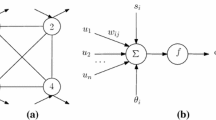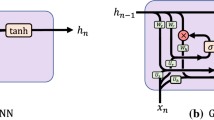Abstract
This paper deals with the relatively new field of designing a Chaotic Pattern Recognition (PR) system. The benchmark of such a system is the following: First of all, one must be able to train the system with a set of “training” patterns. Subsequently, as long as there is no testing pattern, the system must be chaotic. However, if the system is, thereafter, presented with an unknown testing pattern, the behavior must ideally be as follows. If the testing pattern is not one of the trained patterns, the system must continue to be chaotic. As opposed to this, if the testing pattern is truly one of the trained patterns (or a noisy version of a trained pattern), the system must switch to being periodic, with the specific trained pattern appearing periodically at the output. This is truly an ambitious goal, with the requirement of switching from chaos to periodicity being the most demanding. Some related work has been done in this regard. The Adachi Neural Network (AdNN) [1-5] has properties which are pseudo-chaotic, but it also possesses limited PR characteristics. As opposed to this, the Modified Adachi Neural Network (M-AdNN) proposed by Calitoiu et al [6], is a fascinating NN which has been shown to possess the required periodicity property desirable for PR applications. However, in this paper, we shall demonstrate that the PR properties claimed in [6] are not as powerful as originally reported. Indeed, the claim of the authors of [6] is true, in that it resonates periodically for trained input patterns. But unfortunately, the M-AdNN also resonates for unknown patterns and produces these unknown patterns at the output periodically. However, we describe how the parameters of the M-AdNN for its weights, steepness and external inputs, can be specified so as to yield a new NN, which we shall refer to as the Ideal-M-AdNN. Using a rigorous Lyapunov analysis, we shall analyze the chaotic properties of the Ideal-M-AdNN, and demonstrate its chaotic characteristics. Thereafter, we shall verify that the system is also truly chaotic for untrained patterns. But most importantly, we demonstrate that it is able to switch to being periodic whenever it encounters patterns with which it was trained. Apart from being quite fascinating, as far as we know, the theoretical and experimental results presented here are both unreported and novel. Indeed, we are not aware of any NN that possesses these properties!
Access this chapter
Tax calculation will be finalised at checkout
Purchases are for personal use only
Preview
Unable to display preview. Download preview PDF.
Similar content being viewed by others
References
Adachi, M., Aihara, K., Kotani, M.: An analysis of associative dynamics in a chaotic neural network with external stimulation. In: International Joint Conference on Neural Networks, Nagoya, Japan, vol. 1, pp. 409–412 (1993)
Adachi, M., Aihara, K.: Associative dynamics in a chaotic neural network. Neural Networks 10(1), 83–98 (1997)
Adachi, M., Aihara, K.: Characteristics of associative chaotic neural networks with weighted pattern storage-a pattern is stored stronger than others. In: The 6th International Conference On Neural Information, Perth Australia, vol. 3, pp. 1028–1032 (1999)
Adachi, M., Aihara, K., Kotani, M.: Pattern dynamics of chaotic neural networks with nearest-neighbor couplings. In: The IEEE International Sympoisum on Circuits and Systems, vol. 2, pp. 1180–1183. Westin Stanford and Westin Plaza, Singapore (1991)
Aihara, K., Takabe, T., Toyoda, M.: Chaotic neural networks. Physics Letters A 144(6-7), 333–340 (1990)
Calitoiu, D., Oommen, B.J., Nussbaum, D.: Periodicity and stability issues of a chaotic pattern recognition neural network. Pattern Analysis and Applications 10(3), 175–188 (2007)
Freeman, W.J.: Tutorial on neurobiology: from single neurons to brain chaos. International Journal of Bifurcation and Chaos in Applied Sciences and Engineering 2, 451–482 (1992)
Pyragas, K.: Continuous control of chaos by self-controlling feedback. Physics Letters A 170(6), 421–428 (1992)
Nozawa, H.: A Neural-Network Model as a Globally Coupled Map and Applications Based on Chaos. Chaos 2(3), 377–386 (1992)
Chen, L., Aihara, K.: Chaotic simulated annealing by a neural network model with transient chaos. Neural Networks 8(6), 915–930 (1995)
Tsui, A.P.M., Jones, A.J.: Periodic response to external stimulation of a chaotic neural network with delayed feedback. International Journal of Bifurcation and Chaos 9(4), 713–722 (1999)
Hiura, E., Tanaka, T.: A chaotic neural network with duffing’s equation. In: Proceedings of International Joint Conference on Neural Networks, Orlando, Florida, USA, pp. 997–1001 (2007)
Tanaka, T., Hiura, E.: Computational abilities of a chaotic neural network. Physics Letters A 315(3-4), 225–230 (2003)
Tanaka, T., Hiura, E.: Dynamical behavior of a chaotic neural network and its applications to optimization problem. In: The International Joint Conference On Neural Network, Montreal, Canada, pp. 753–757 (2005)
Calitoiu, D., Oommen, B.J., Nussbaum, D.: Desynchronizing a chaotic pattern recognition neural network to model inaccurate perception. IEEE Transactions on Systems Man and Cybernetics Part B-Cybernetics 37(3), 692–704 (2007)
Qin, K., Oommen, B.J.: Chaotic pattern recognition: The spectrum of properties of the adachi neural network. In: da Vitoria Lobo, N., Kasparis, T., Roli, F., Kwok, J.T., Georgiopoulos, M., Anagnostopoulos, G.C., Loog, M. (eds.) S+SSPR 2008. LNCS, vol. 5342, pp. 540–550. Springer, Heidelberg (2008)
Qin, K., Oommen, B.J.: An enhanced tree-shaped adachi-like chaotic neural network requiring linear-time computations. In: The 2nd International Conference on Chaotic Modeling, Simulation and Applications, Chania, Greece, pp. 284–293 (2009)
Qin, K., Oommen, B.J.: Adachi-like chaotic neural networks requiring linear-time computations by enforcing a tree-shaped topology. IEEE Transactions on Neural Networks 20(11), 1797–1809 (2009)
Nagumo, J., Sato, S.: On a response characteristic of a mathematical neuron model. Biological Cybernetics 10(3), 155–164 (1971)
Eckmann, J.P., Rulle, D.: Ergodic theory of chaos and strange attractors. Reviews of Modern Physics 57(3), 617–656 (1985)
Sprott, J.C.: Numerical calculation of largest lyapunov exponent (1997)
Wolf, A., Swift, B.J., Swinney, L.H., Vastano, A.J.: Determining lyapunov exponent from a time series. Physica 16D, 285–317 (1985)
Sandri, M.: Numerical calculation of lyapunov exponents. The Mathematica Journal, 78–84 (1996)
Qin, K., Oommen, B.J.: Networking logistic neurons can yield chaotic and pattern recognition properties. In: IEEE International Conference on Computational Intelligence for Measure Systems and Applications, Ottawa, Ontario, Canada, pp. 134–139 (2011)
Luo, G.C., Ren, J.S., Qin, K.: Dynamical associative memory: The properties of the new weighted chaotic adachi neural network. IEICE Transactions on Information and Systems E95d(8), 2158–2162 (2012)
Adachi, M., Aihara, K.: An analysis on instantaneous stability of an associative chaotic neural network. International Journal of Bifurcation and Chaos 9(11), 2157–2163 (1999)
Author information
Authors and Affiliations
Editor information
Editors and Affiliations
Rights and permissions
Copyright information
© 2013 Springer-Verlag Berlin Heidelberg
About this chapter
Cite this chapter
Qin, K., Oommen, B.J. (2013). Ideal Chaotic Pattern Recognition Is Achievable: The Ideal-M-AdNN - Its Design and Properties. In: Nguyen, N.T. (eds) Transactions on Computational Collective Intelligence XI. Lecture Notes in Computer Science, vol 8065. Springer, Berlin, Heidelberg. https://doi.org/10.1007/978-3-642-41776-4_2
Download citation
DOI: https://doi.org/10.1007/978-3-642-41776-4_2
Publisher Name: Springer, Berlin, Heidelberg
Print ISBN: 978-3-642-41775-7
Online ISBN: 978-3-642-41776-4
eBook Packages: Computer ScienceComputer Science (R0)




